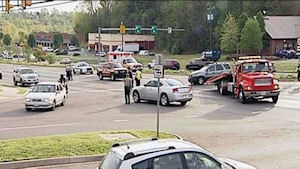The McDonnell administration’s defense of the $244 million+ Charlottesville Bypass as a boon to traffic safety on U.S. 29 falls apart under close scrutiny.
by Randy Salzman
With apologies to Lewis Carroll, Charlottesville’s so-called Western “Bypass” project gets “curiouser and curiouser.”
Each argument for the 6.2-mile highway collapses quickly if anyone does third-grade math. This highway built for trucks that trucks can’t use will need another $56 million added to the $244 million already allocated by Virginia to make it usable and then will save truckers, VDOT analyzes, only 66 seconds off the 10-hour drive from Lynchburg to NYC. Would any manufacturer build a plant anywhere on the planet to save a minute off full-day travel, as downstate proponents argue?
VDOT, meanwhile, consistently reports the “Bypass” will do nothing for Albemarle County congestion. Since only 10 to 12 percent of the 47,641 to 51,939 vehicles per day on U.S. 29N pass through the area while 90 percent are local, the intersections along 29N will remain an F level of service after Virginia borrows a fortune to build this expensive four-lane highway, which terminates south of two large, growing neighborhoods and the area’s largest shopping mall.
Recently, the safety argument also fell by the wayside. According to VDOT Traffic Engineer Robert Rasmussen, in a letter forwarded to Albemarle County supervisors, in 2010 there were 260 accidents, or 305 per 100 million vehicle miles of travel, along 3.3 miles of U.S. 29 that the “Bypass” is supposed to relieve.
That’s a stiff rate; one of the highest in the state.
All but a handful of accidents, however, take place at the intersections of Hydraulic and Rio Roads with U.S. 29. If the intersections are excluded, the accident rate drops to 77 per 100 million vehicle miles of travel. Nearly four four in five wrecks would be prevented if Virginia stuck to its original “three-party agreement,” which promoted overpasses at Rio and Hydraulic.
In the early 1990s, VDOT’s three-party agreement sequenced possible projects along U.S. 29 north of Charlottesville and concluded the overpasses should be built first. Only if all the other improvements failed to solve traffic issues, and if funding was available, would a bypass be considered. It was clear then that a bypass would not solve local congestion or local intersection accidents.
Yet in 2012 Secretary of Transportation Sean Connaughton tried to make safety a primary justification for the bypass, stating in correspondence that “900 crashes in Albemarle County” represent “almost 50% of all crashes along the entire Route 29 corridor from North Carolina to the Fauquier/Prince William County Line.”
VDOT’s April 2010 report illustrates the secretary not only can’t fathom the borrowed dollars he’s dumping on future generations, he also has trouble with third-grade math. Of the 7,103 crashes over three years that VDOT notes along U.S. 29 in Virginia, 887 are indeed in Albemarle County. Run the numbers. That’s about one accident in every 12 and nowhere close to “almost 50%.” Read more.



